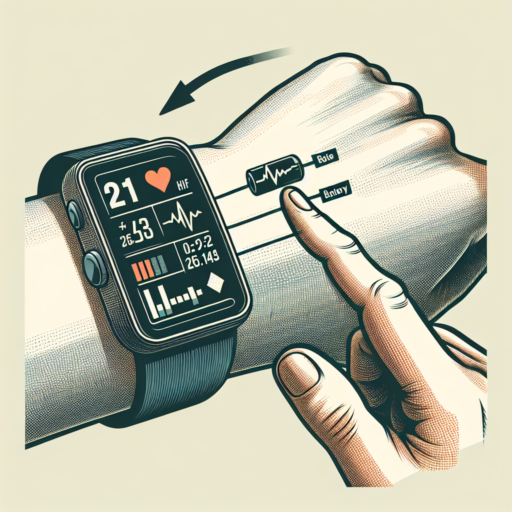Understanding Heart Rate Variability (HRV): Why It Matters
Heart Rate Variability (HRV) is a vital biometric that is gaining traction in health and wellness circles for its profound implications on our overall well-being. At its core, HRV measures the variation in time between each heartbeat, which is controlled by the autonomic nervous system (ANS). Understanding HRV is crucial because it is a direct indicator of our autonomic nervous system’s balance and, by extension, our body’s ability to manage stress and recover.
HRV is more than just a number; it is a mirror reflecting the state of our physical and psychological health. A higher HRV suggests a body that is well-rested, resilient, and capable of efficiently managing stress. Conversely, a lower HRV can indicate stress, fatigue, or even underlying health issues. What makes HRV especially valuable is its role as a proactive tool; tracking HRV can help flag potential health issues before they become problematic, offering a critical window for intervention and lifestyle changes.
Moreover, HRV has applications that extend beyond personal health monitoring. It is increasingly used by athletes to optimize training schedules, by individuals focused on improving mental health, and even in corporate wellness programs to enhance employee health and productivity. The ability to measure and interpret HRV opens up new avenues for personalized health and fitness plans, making it a cornerstone of modern preventive medicine and wellness practices.
The Link Between HRV and Your Overall Health
Understanding the link between Heart Rate Variability (HRV) and overall health is crucial in today’s fast-paced world. HRV refers to the variation in time intervals between heartbeats and is a reliable indicator of the autonomic nervous system’s (ANS) functionality. The ANS controls involuntary physiological functions, making HRV a crucial metric in gauging one’s stress levels, recovery, and overall well-being.
HRV as a Predictor of Stress and Recovery
One of the key aspects of HRV is its ability to serve as a predictor of stress and recovery. High variability indicates a healthy balance between the sympathetic and parasythetic nervous systems, showcasing the body’s adaptability to stressors. Conversely, low HRV suggests a reduced capacity to adapt, signaling increased stress or inadequate recovery. By monitoring HRV, individuals can make informed decisions about managing stress, optimizing workouts, and improving recovery processes.
Enhancing Overall Health through HRV Monitoring
Monitoring HRV also offers insights into broader health implications. It enables early detection of potential health issues, guides the management of anxiety and depression, and supports cardiovascular health. Regular tracking of HRV can assist individuals in identifying the impacts of lifestyle choices on their health and making necessary adjustments. Thus, understanding and applying HRV data can lead to significant improvements in overall health and well-being.
Top Activities to Increase Your HRV
Heart Rate Variability (HRV) is a key health metric that reflects the variations between consecutive heartbeats. A higher HRV is typically associated with better cardiovascular fitness, reduced stress levels, and overall well-being. Engaging in certain activities can effectively boost your HRV, contributing to stronger heart health and resilience against stress and anxiety.
Practice Mindful Meditation
Meditation has been proven to have a profound impact on HRV, promoting relaxation and reducing stress. Regularly dedicating time to mindful meditation can help in synchronizing the heart and brain, improving not just HRV but also enhancing emotional regulation and reducing anxiety.
Engage in Regular Physical Exercise
Physical activity is another critical component in boosting your HRV. Activities such as yoga, swimming, or even brisk walking can significantly improve your cardiovascular fitness, increasing HRV over time. It’s crucial to include a mix of aerobic and strength-training exercises for optimal benefits.
Adopting these activities into your daily routine can make a notable difference in your HRV levels. By focusing on improving your HRV, you’re not just working towards better heart health, but you’re also taking a step towards enhancing your overall quality of life.
How Nutrition and Hydration Affect HRV
Nutrition and hydration play critical roles in maintaining and improving Heart Rate Variability (HRV), a vital marker of cardiovascular and overall health. HRV refers to the variation in time between consecutive heartbeats, and it’s influenced by various factors, including the quality of our diet and fluid intake. Understanding the connection between these elements can pave the way for optimized physical performance and wellbeing.
Impact of Nutrition on HRV
The kind of fuel we provide our bodies significantly impacts HRV levels. A diet rich in antioxidants, healthy fats, and balanced macronutrients can improve HRV by reducing inflammation and supporting the nervous system. Foods high in omega-3 fatty acids, such as salmon and flaxseed, have been shown to enhance HRV, indicating better stress resilience and heart health. On the contrary, diets high in processed foods and sugars may lead to a diminished HRV, reflecting poor cardiovascular condition and a heightened stress response.
Hydration’s Role in HRV
Hydration is another crucial ingredient for maintaining a healthy HRV. Adequate fluid intake ensures that the heart can pump blood efficiently, resulting in more variability between heartbeats. Dehydration, however, can strain the cardiovascular system by increasing heart rate and blood pressure, subsequently leading to lower HRV scores. Ensuring consistent hydration, especially with water and electrolyte-balanced drinks, can help sustain optimal HRV levels.
Incorporating a balanced diet and maintaining proper hydration are straightforward yet powerful strategies to positively influence HRV. By focusing on these aspects of health, individuals can enhance their heart’s responsiveness and overall resilience against stress. The integration of nutrition and hydration into HRV management highlights the body’s interconnected systems and the multifaceted approach needed for holistic well-being.
The Impact of Stress on Your HRV and How to Manage It
Understanding the connection between stress and Heart Rate Variability (HRV) is crucial for managing overall wellbeing. When stress levels rise, it can significantly affect your HRV, a key indicator of heart health and autonomic nervous system balance. High stress can lead to a lower HRV, signaling less resilience to stress and potentially leading to long-term health issues.
Identifying the Impact of Stress on HRV
Stress triggers a series of physiological responses in the body, directly impacting HRV by activating the sympathetic nervous system (SNS) and suppressing the parasympathetic nervous system (PNS). This imbalance, characterized by a decrease in HRV, indicates that the body is under stress and not recovering adequately. Continuous monitoring of HRV can, therefore, serve as a crucial tool in identifying and managing stress levels effectively.
Strategies to Mitigate Stress and Improve HRV
- Mindfulness and Meditation: Regular practice can enhance parasympathetic activity, increasing HRV and building resilience to stress.
- Physical Activity: Engaging in consistent, moderate exercise boosts HRV by strengthening heart health and stress tolerance.
- Quality Sleep: Improving sleep quality can substantially elevate HRV, as restorative sleep enhances the balance between the SNS and PNS.
Improving Sleeping Habits to Boost HRV
Improving your sleep patterns can play a pivotal role in enhancing your Heart Rate Variability (HRV), which is a key indicator of your cardiovascular and overall health. The quality and quantity of sleep you get each night directly influence your body’s ability to recover, impacting your HRV scores positively. Prioritizing good sleep hygiene is essential for maintaining a healthy balance between your sympathetic and parasyptic nervous systems, which in turn, improves HRV.
Implementing a Consistent Sleep Schedule
Maintaining a consistent sleep schedule is a cornerstone of healthy sleep habits that can boost your HRV. Going to bed and waking up at the same time each day helps regulate your body’s internal clock, or circadian rhythm, which improves sleep quality and efficiency. This regularity not only makes it easier to fall asleep but also deepens the restorative phases of sleep, thereby enhancing HRV over time.
Optimizing the Sleeping Environment
Creating an environment conducive to sleep is critical for enhancing your HRV. This means minimizing exposure to blue light from screens before bed, ensuring your bedroom is cool, dark, and quiet, and investing in a comfortable mattress and pillows. These adjustments can significantly improve the quality of your sleep, allowing your heart rate variability to benefit from uninterrupted, deep sleep cycles.
Understanding and improving your sleep habits are key steps towards not only boosting your HRV but also enhancing your overall health and well-being. Through consistent efforts and adjustments in your sleep routine and environment, you can significantly improve the quality of your sleep—and by extension, your heart rate variability. Embracing these changes can lead to noticeable improvements in how you feel both physically and mentally, day in and day out.
Exercise and HRV: Finding the Right Balance
Finding the perfect equilibrium between physical activity and heart rate variability (HRV) is crucial for both fitness enthusiasts and athletes. HRV measures the time variation between consecutive heartbeats, an indicator of autonomic nervous system balance and cardiovascular health. Regular exercise can significantly influence your HRV, reflecting the body’s ability to manage stress, recover, and maintain a healthy heart rhythm.
The Impact of Exercise Intensity on HRV
Not all exercises influence HRV in the same manner. High-intensity workouts, like sprinting or HIIT (High-Intensity Interval Training), can initially decrease HRV, indicating acute stress and higher demands on the body. However, with adequate rest, this could lead to improved HRV over time, denoting enhanced resilience and cardiovascular health. Conversely, moderate-intensity activities, such as brisk walking or cycling, might boost HRV more consistently, promoting recovery and stress reduction. Understanding the intensity and frequency of your workouts is essential to harness the benefits of exercise without overburdening the heart.
Customizing Your Exercise Routine for Optimal HRV
Personalizing your training plan according to your unique HRV readings can be a game-changer in health and fitness achievements. It involves recognizing your body’s signals and adjusting the intensity, duration, and type of exercise accordingly. For instance, on days when your HRV is low, which suggests fatigue or stress, opting for lighter, recovery-focused activities such as yoga or gentle stretching might be more beneficial. In contrast, when HRV readings are high, indicating good recovery and low stress levels, it’s an opportune time to engage in more challenging workouts. Regular monitoring of HRV can thus serve as a potent tool in training optimization, ensuring not just performance enhancement but also longevity in fitness ventures.
Monitoring Your HRV: Tools and Tips
Tracking your Heart Rate Variability (HRV) can unveil insights into your physical fitness, stress levels, and overall well-being. With the advancements in wearable technology and mobile apps, monitoring your HRV has never been easier. This article explores the critical tools and practical tips to help you harness the power of HRV tracking effectively.
Choosing the Right HRV Monitoring Tool
When it comes to monitoring your HRV, the market is flooded with options ranging from high-tech smartwatches to specialized HRV sensors. The key is to find a device that integrates seamlessly into your lifestyle and provides accurate readings. Brands like Garmin, Polar, and Whoop offer devices not only to measure your HRV but also to interpret the data in a user-friendly way. Ensure the device you choose has a good track record of accuracy and reliability, as this is crucial for actionable insights.
Understanding Your HRV Readings
Monitoring your HRV is more than just collecting data; it’s about understanding what your numbers mean. A higher HRV indicates a healthier, more resilient cardiovascular system, while lower HRV readings can signal stress, fatigue, or underlying health issues. It’s important to track your HRV over time and in relation to lifestyle factors such as sleep, exercise, and diet. Apps that pair with your monitoring device can help interpret these readings, providing personalized tips to improve your HRV and, by extension, your health and wellness.
Embracing a holistic approach to HRV monitoring involves paying attention to both the tools and the interpretation of the data they provide. Whether you’re an athlete looking to optimize your performance or someone interested in improving their overall health, monitoring your HRV can offer valuable insights that empower you to make informed decisions about your lifestyle and activities. Selecting the right tool and understanding the nuances behind your HRV readings are fundamental steps in this journey.
Incorporating Mindfulness and Meditation to Raise HRV
Heart Rate Variability (HRV) is increasingly recognized as an important marker of health and stress resilience. In today’s fast-paced world, it is more important than ever to focus on practices that can enhance our well-being. Mindfulness and meditation are powerful tools in this quest, offering a path to elevate HRV and, as a result, improve overall health. Understanding the connection between these practices and HRV opens up new avenues for enhancing physical and mental health.
Why HRV Matters
HRV measures the variation in time between each heartbeat, and it’s a critical indicator of the nervous system’s health and balance. A higher HRV suggests a more adaptable heart, capable of efficiently managing stress and recovery. Incorporating mindfulness and meditation into your daily routine can significantly impact HRV by fostering a state of relaxation and equilibrium. These practices facilitate a shift from the fight-or-flight response to a rest-and-digest state, thereby nurturing a healthier heart rhythm and improving HRV.
Practical Tips for Mindfulness and Meditation
- Start Small: Begin with short, daily sessions of meditation, even just five minutes can make a difference.
- Create a Routine: Dedicate a specific time and place for your practice to help establish it as a habit.
- Focus on Breathing: Concentrate on deep, slow breaths to help anchor your mind in the present moment.
- Use Apps and Tools: Leverage technology with guided meditations and HRV tracking to enhance your practice and monitor progress.
By thoughtfully integrating mindfulness and meditation into your life, you’re not just improving your HRV; you’re taking a proactive step towards a calmer, healthier existence. While the journey towards higher HRV through these practices requires consistency and patience, the benefits to your well-being are well worth the effort. Remember, the aim is not to perfect meditation but to make room for mindfulness in your life, allowing for a natural improvement in heart health and resilience.
Case Studies: Real-Life Improvements in HRV
Exploring the realm of Heart Rate Variability (HRV) offers insight into the intricate balance of the human nervous system and its substantial impact on our overall health. By examining case studies that spotlight real-life improvements in HRV, we can understand the tangible benefits of interventions tailored towards enhancing this critical health metric. Whether through lifestyle changes, targeted exercises, or mindfulness practices, the following narratives illuminate the potential for positively influencing our physiological wellbeing.
One notable case study involved a middle-aged individual struggling with chronic stress and poor sleep quality. By implementing a structured routine that encompassed regular aerobic exercise, dietary modifications to include heart-healthy nutrients, and guided meditation exercises, the subject demonstrated a remarkable improvement in HRV over several months. This case underscores the effectiveness of a holistic approach to bolstering heart rate variability and, by extension, stress resilience and overall health.
Another compelling example comes from a workplace wellness program designed to enhance employee wellbeing through stress management and physical activity. Participants engaged in daily mindfulness practices and received education on sleep hygiene. Pre- and post-program assessments showed a significant uplift in HRV metrics, highlighting the value of integrating mental health and physical wellness strategies in corporate environments.










